Consoled by the Brahmaputra
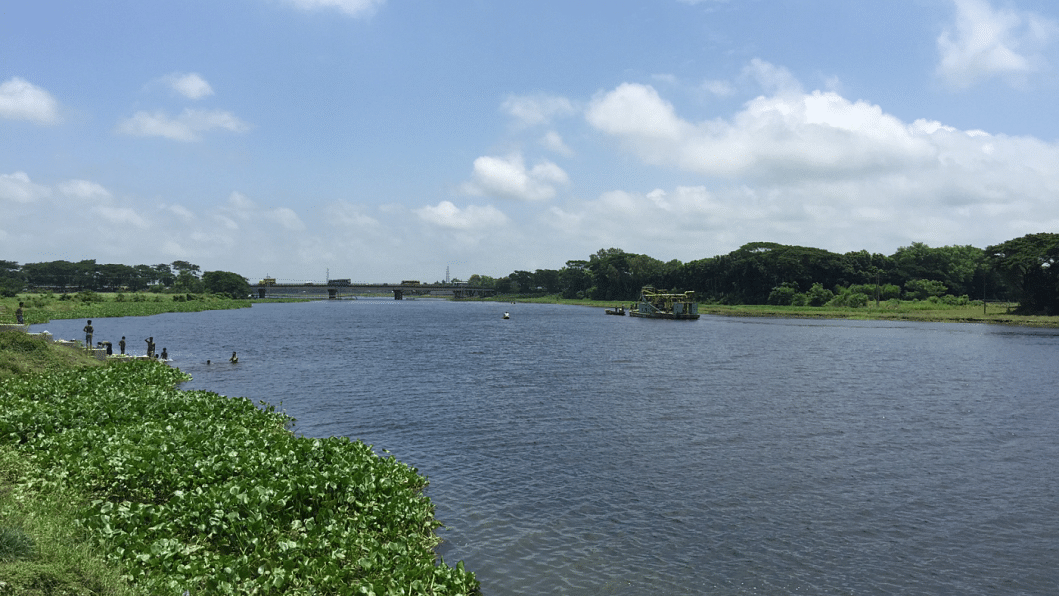
July 1, 2016. I spent the afternoon with my frail 80-year-old mother. Despite dementia, she was lucid. With a white tajbih and an old Koran in her hand, she asked if I prayed juma, if we wanted spicy piaju for iftar, if Renia, my 7-year-old, her namesake and a product of two worlds, is all packed for the flight the next day to see her nanu in the US.
Later, braiding her thinning grey hair, she told stories of her parents. A 7-year-old in the 1940s, she travelled with them by steamer from Bikrampur to see her brothers in Calcutta. Even at 7, she knew how to recite the Koran. A river of warmth running through three generations spanning two centuries, rippling away on a torn couch in a sticky Dhaka afternoon, evoked gratitude.
We left my mother's place early to finish packing. Driving through Gulshan Road 75, punctuated by irregular lights and leafy tall trees, we reached home after 8:00pm. I lay down with a headache. Minutes later, came the sound of firecrackers. An hour later came the SMS: "Holey Artisan Bakery is under siege; situation is NOT UNDER CONTROL."
I called my friend Chotu. Renia, sitting next to the half-packed suitcases, learned from my hushed, hurried conversations that those were gunshots and grenades, not firecrackers; multiple attacks might be underway. Unsure and scared, she looked for Shaila, her 3-year-old sister. We huddled in our living room, away from the windows. A precious afternoon thus vanished into a night of horror.
Awake, lying next to Renia, only two hundred metres from Holey, I kept thinking about how it might end. She finally fell asleep after midnight. At 3:43am, curled up in a fetal position, she twitched as the Fazr azaan crawled into our balcony, vandalising the fragile calm. In a fog of unfamiliar fear, I had only water for seheri.
"Renia later told her mother that they could no longer go outside in Dhaka because her mother is not from Bangladesh. In such situations, there are no words to console, no means to explain.
The next morning, the gunshots and blasts started around 7:30am. Renia ran over from where she had been playing with her little sister. With the reverberations on the buildings, it was impossible to tell what was happening inside Holey and outside in the neighbourhood. There, a few days earlier, we had celebrated Renia's birthday. Around 11am, in a short, sombre call Adeeb bhai confirmed that his nephew Faraaz had been there.
Grisly news and pictures kept pouring in all day, as punishing gloom filled the Dhaka sky. Witnesses later recounted how, despite given the choice, Faraaz refused to leave Holey. He stayed back to protect his friends, Bangladeshi-American Abinta and Tarishi from India, transcending religion, gender, and nationalities.
On that unaccustomed day, no one quite knew how to feel. I called my sister, "Don't let amma watch TV." Under the weight of her faith and dementia, all this would be too disorienting, no less than it was for Renia. Renia later told her mother that they could no longer go outside in Dhaka because her mother is not from Bangladesh. In such situations, there are no words to console, no means to explain.
Unsure if she belonged to the land she inherited from her father, Renia felt targeted. The stories she grew up with crumbled overnight. It had not been even a year since I returned to Bangladesh after twenty four-years to grow her roots. Later that evening, standing at the long airport security queue, she looked back, "Abba, please don't go outside." I kissed her forehead and lied, "Don't worry ma, I won't." I felt sick from a mix of emptiness and relief as the plane vanished like a thief into the black sky.
With Renia gone, Ramadan afternoons grew longer than the afternoon shadows. The pre-Eid roads, soaked in the monsoon rains, were empty. I spent most evenings on the cheap yellow couch I bought ten years ago in Washington from a Syrian neighbour. I would catch myself glancing at the Buddhist statues I brought from Cambodia, my home during 2011-2015. With passing days, their serene faces grew more homeless. My friend Lori later explained, "It's called projection."
***
In less than a week, Eid arrived tastelessly like an uninvited guest. I was glad Renia missed this Dhaka Eid, wrapped around with 22 funerals of different faiths across the world. For the Eid prayer, I walked to the mosque braving the summer morning drizzle, avoiding the raw potholes to keep my leather sandals half-dry. The drizzle had the sad lethargy of a snowfall.
On my right, behind the rusty fence of Baridhara park, through the rain-bathed, violently green leaves and the gory red krishnachuras, peeked a reflection of Holey floating on the lake. The white chairs on Holey's second floor looked hauntingly abandoned. The vines over the brick wall looked lost. I saw violence and gloom even in my favourite colours and trees—red, green, and krishnachuras. During that week, Baridhara lake had turned greener with algae, swollen by rain and fear.
"Perhaps, the resiliency in us comes from the relentless, hungry rivers in our nimble delta, surviving the constant feud between land and water stoked by the monsoon rain. Perhaps, our fierce individualism borne out of that feud gave us the confidence for peaceful coexistence amid diversities and adversities.
A week of rain had also cleaned the red-brick Baridhara mosque, now apologetically standing like a high-risk airport with two dog squads and an electronic gate manned by pot-bellied guards in uniforms. The dogs comforted humans in the house of God.
I went to my usual spot, fourth row, second floor, now empty. So I moved to the front row. There, men in colourful punjabis glanced at each other a bit longer than usual, being alert without being too obvious. Trust, like the arthritic cartilage in my mother's aging knees, had thinned. The Eid jamat had a funeral feel. I skipped the khutbah, left early. On the staircase, the sandals were all wet, strewn like dead soldiers.
I came back to my empty apartment and turned on the TV. Sholakia, the largest Eid jamat, was attacked. It could have killed hundreds. Senseless violence tore apart lives at home and abroad: Istanbul. Dhaka. Sholakia. Nice, France.
Violence has long been common in us, in humanity, and in the name of all faiths. But Holey was so close, so brutal, so blind, and so unexpected. This violence violated everything I wanted to assume about us.
Who are we? What are we made of? What have we become?
I internalised Holey through the eyes of my bicultural daughters, the faith of a devout grandmother, and the tenderness of a timid father. Unnervingly, this cocktail convinced me that I am not brave. In a long-delayed revenge, my social bubble could neither shield nor comfort me. In fact, the earthquake this time happened inside the bubble.
After Holey, I discovered the architecture of fear is confusing. In concentric circles, fear becomes anxiety, then trauma, then phobia. Underneath our fear often lies a belief; in fact, a broken belief that can injure our innocence, invade our imagination, and ultimately, fracture our faith in humanity. So any healing has to start in our belief, in our imagination.
Looking back, since I lost my father in my teens, I have known that life is fragile and random. I have since been paranoid of losing my loved ones. In difficult periods, I often found oxygen in long walks, in mathematics, and in history. Long walks repaired fragile memories. Mathematics gave orderly beauty amid random grief. History helped me resurrect my father when I missed him; it also instilled in me a belief that we all are rivers, a complex flow of continuity and contradictions.
Rivers rise, fall, shift, bend, loop, criss-cross. They water our memories, nourish our imagination, quench our thirst, inseminate our songs, devour our homes, leave silt after the floods to console us with bumper crops. Like Brahma, they create; like Shiva, they destroy. Beautiful, kind, cruel, volatile, resilient, all at once, rebelling against all rigid definitions and otherness, washing away our past to invite the future. Like cultures, rivers embrace everything on their way.
Perhaps, it is the fluid geography and the frontier ecology of our rivers, our soil, our forests, our villages that have shaped our psyche, the melody of our songs, the pulse in our poetry, and the genes of our syncretic faith. Perhaps, the resiliency in us comes from the relentless, hungry rivers in our nimble delta, surviving the constant feud between land and water stoked by the monsoon rain. Perhaps, our fierce individualism borne out of that feud gave us the confidence for peaceful coexistence amid diversities and adversities.
***
July 15, 2016. Two weeks after Holey, on a sun-soaked Friday with a blue sky dotted by ambitious, puffy white clouds, with frayed faith and imagination, I went to Sonargaon for oxygen. There lies a slice of our sleepy past corralled by a fluid rectangle of rivers: the old Brahmaputra, Meghna, Dhaleshwari, and Sitalakhya.
Brahmaputra grew old a while ago. In 1762, halfway between the sunset of 1757 when Bengal lost its independence and the famine of the 1770s that killed one-third of its 30 million inhabitants, a massive earthquake shifted Brahmaputra's course, aging the only male-named river connecting the Kailash mountain, Shiva's ascetic residence, to Sonargaon. Brahmaputra nourishes lands—China, India, Bangladesh—that housed half of humanity. Its banks replenished artist Zainul Abedin all his life; its floods likely devoured Wari-Bateshwar, our 2500-year-old fort city, an emporium Greek writer Ptolemy perhaps referred to as "Sounagora" in his book Geographia.
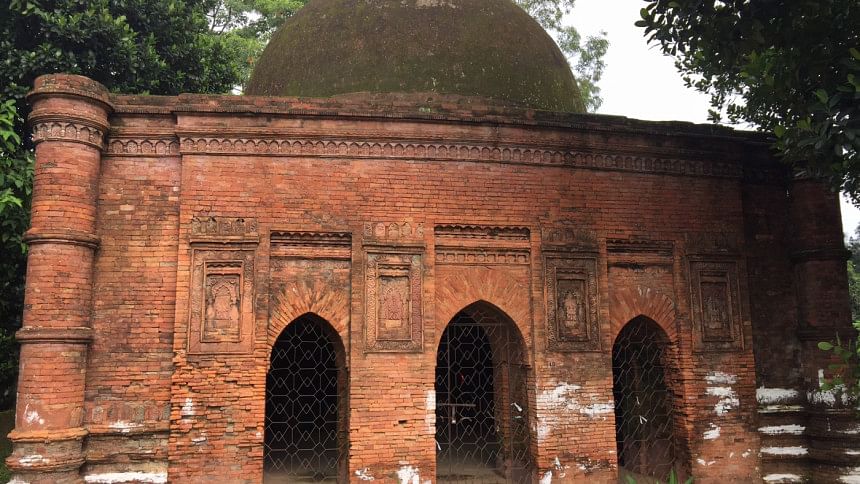
In Sonargaon, around a mile from Panamnagar, my first stop was the 500-year-old Goaldi mosque. Its red bricks have survived a thousand full moons and seamless seasons under a small, beautiful dome, an echo of the Buddhist stupa in Sanchi, Madhya Pradesh commissioned by Emperor Asoka. The lotus motifs in its spandrels resemble the lotuses generally held by the Hindu god, Surya. Within a ten-minute walk, right behind a small bazaar, is the Sufi shrine of Hazrat Abu Tawaa. He came to our frontier land from Bukhara, Uzbekistan, via Delhi in the 1270s. Another Sufi, Hazrat Daneshmand from Bagdad, who arrived earlier, supported him in sharing Sufism in Sonargaon. They both are now sleeping there, attended by eager men wearing lalsalu in a shrine that has been painted gaudy green.
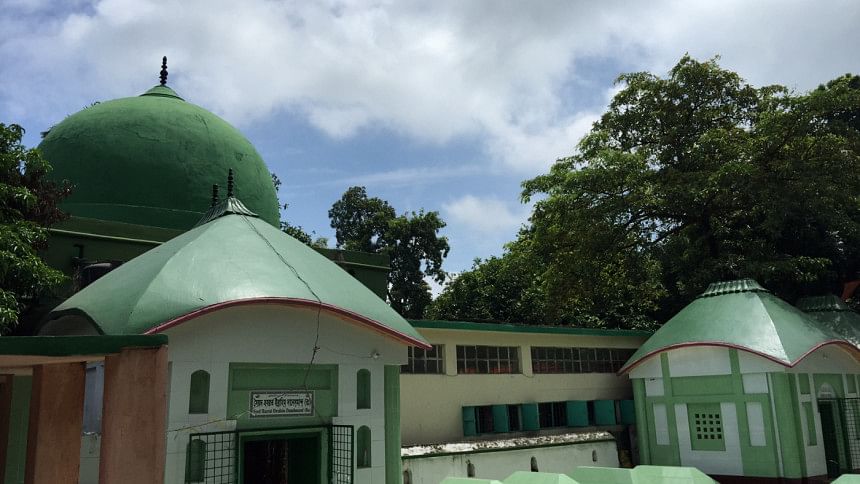
The 13th-century world suffered a lot of violence—the fourth crusades from the West and the Mongol rampage from the East unleashed by Genghiz Khan. The Mongol violence in Baghdad and Central Asia and its aftermath catalysed the migration of Sufis to our subcontinent. It is ironic that Sufi Islam, with its message of love and inclusion, was partially an export of an earlier era of violence.
The Bengal Sultanate (1300s-1500s) was a time of fusion. Around then, Bangla, the language we fought for in 1952, evolved into its current form. During Sultan Giyashuddin Azam Shah's rule, poet Krittibas Ojha translated the Ramayana into Bangla as Krittivasi Ramayan, which helped the emergence of Vaishnavism in Gangetic Bengal. Also around 1500, the Muslim ruler of Chittagong commissioned his court poet Kavindra Parameshvara to translate the Mahabharata into Bangla. Nobody can better capture the humanistic spirit of the era than poet Chandidas in the 15th century: Sobar upore manus sotto, tahar upore nai.
I grew up with the stories of Sonargaon told and retold by my mother. Her ancestral village in Bikrampur is not too far from Sonargaon. In the uncertain world of the 1270s, long after the fourth crusade and the Mongol's decimation of Baghdad, around when Afghan-born poet Rumi died in pre-Ottoman Turkey and Venetian Marco Polo reached Kublai Khan's opulent summer palace in Xanadu in the Ming China, Hazrat Abu Tawa came to Sonargaon from Uzbekistan. It is in that globalised, violent world, Raja Danuja Rai of Bikrampur moved his capital to Suvarnagrama, now Sonargaon, for better security.
Like now, the world then kept fidgeting. In the next wave of security needs, 300 years later, the Mughals again moved the capital from Songargaon to Dhaka. The cascade of capitals spanning the last millennia—Bikrampur, Sonargaon, and Dhaka—oddly reminded me of my mother, myself, and Renia on that torn couch on July 1, three distinct generations, connected by a river of complex inheritance.
I became interested in the Buddhist Bikrampur since my stint in Cambodia. As the first millennia came to a close in the Buddhist Pala Bengal, long before Cambodia's Angkor Wat, a child named Chandragarva was born in Bajrajogini, not too far where my mother was born a thousand years later. That child later grew up to be Atish Dipankar who became Asia's leading Buddhist reformer. He took his final rest 3,000km upstream on the banks of Brahmaputra in Tibet, where it is named Tsangpo, "purifier." Brahmaputra connects the land of his final rest to the land of first breath. The school of Buddhism to which the Dalai Lama belongs emerged out of Atish Dipankar's teachings. Sadly, but revealingly, his birthplace near Rampal, Munshiganj is now known as nastik panditer bhita.
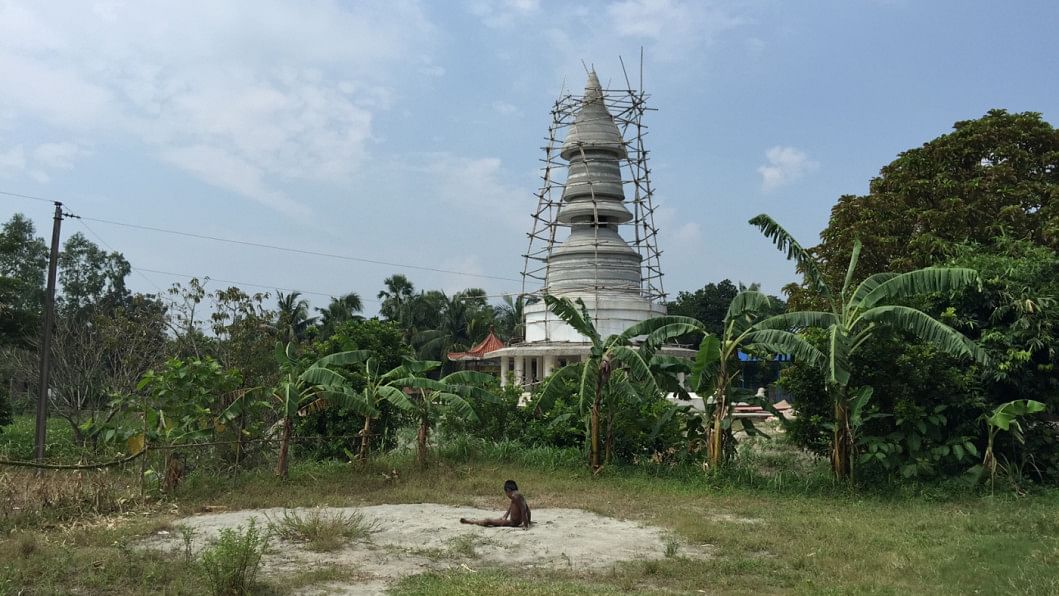
After the Goaldi mosque, I wanted to see the old Brahmaputra up close and got off the Dhaka-Chittagong highway. Around noon, following a short drive, then a walk as the paved road turned to gravel, I reached the Langalbandh ghat. There, in the short midday shadow of a tall banyan tree with exposed interwoven roots, I saw people who did not know each other sitting in a circle around those roots: a man with his well-planned wrinkles, hena-dyed beard, and a white tupi ready for juma; a woman with sindoor on her black parting hair and her family; two women with black hijabs barely revealing their eyes; teenagers staring at the smartphones with intense love, busy taking selfies with pouty lips and fake dimples.
That circle of Bangladeshis exuded harmony. Of all the geometric shapes, I always felt closest to the circle. It is made of infinite, equal points, with a timeless flow among them that has no beginning or end. In a poetry of mathematics, sitting next to one another, together, they build and live for something far bigger than themselves, all around a shared centre. A dome, like the one on the Goaldi mosque or the Sanchi Stupa, is also made of infinite circles of different sizes to reach their three dimensional dreams.
That banyan tree in Langhalbandh and the Goaldi mosque together embraced so much of our common past. They both watched so many floods and droughts, full moons and gentle suns, high and low tides, dusks and dawns, fakirs and sanyasis, bauls and beggars, spirits and djinns, happy families and broken souls; Buddha purnimas, Pujas, Eids; even famines, riots, stampedes, and wars; the temporary partition of Bengal in 1905; the violent partition of India in 1947; the disintegration of Pakistan. Jubilantly, the painful birth of Bangladesh in 1971. But, throughout, the perennial proximity of faiths in our fidgety delta.
On the ghat, a father and a son were taking a holy dip in the Brahmaputra. I thought of my own father. And all those who came before me: Pirs from Uzbekistan; Sufis from Baghdad; soldiers from Ethiopia; rulers from Afghanistan; the giraffe brought by the Kenyan sailors that Sultan Ghiyasuddin sent as a tribute to the Ming Emperor Yongle to counterbalance the Delhi Sultanate; traders from Portugal; Maghs from the Arakan; Swami Vivekanda and his mother in 1901; the seven women and three men who died in the Astami Snan stampede in 2015; my ancestors whose names I don't even know.
Blessed by the ghat, a Friday haat was humming behind the banyan tree whose heart-shaped leaves were rustling in the ancient summer breeze from the Brahmaputra. In that cool breeze, a confident man wearing a pink shirt was selling a medicine that promised to cure all diseases, from trivial to intimate. Others were busy selling jackfruits, sugarcane, betel leaf, pigeons in bird cages, spices in recycled cement bags, milk tea made from a small stove.
Around 12:30pm, the juma azaan drowned out the fading sound of an engine boat carrying cargoes and families. I went for juma in a nearby mosque of corrugated tin and red bricks. We huddled behind the imam. The prayer rows were all full and the khutbah short.
Inside the mosque cooled by the old Brahmaputra, as I closely looked at the eyes, the noses, and the faces of those praying around me, in a whispered echo of nostalgia, amateur anthropology, and unflattened history, I felt a silhouette of the answer to "Who are we?"
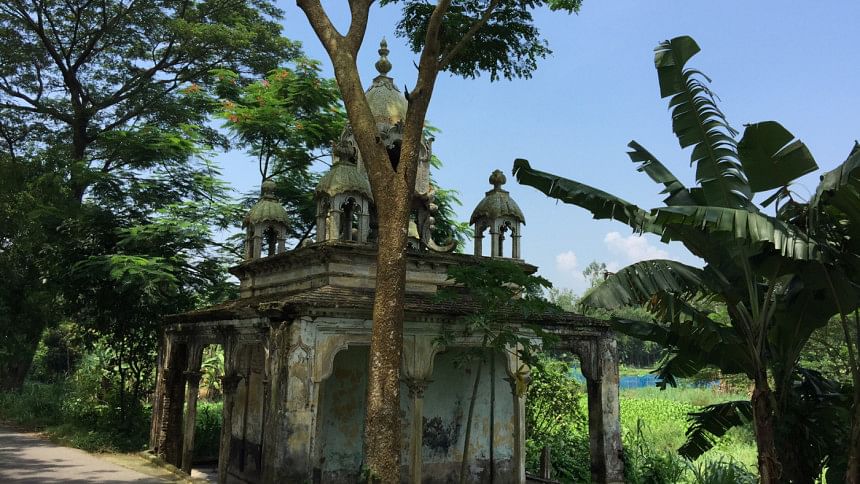
We are a layered khichuri of humanity mashed by the monsoon rains over three thousand years: Austroasiatic, Mongoloid, Indo-Aryan, Dravidian, Arabs, Turks, Ethiopians, Afghans, Animist, Buddhist, Hindu, Muslim, Christian, all interwoven by time like a muslin sari on the banks of the Sitalakhya. Our mosques, our viharas, our temples, our shrines all are made of red bricks, a geometric aspiration of our deltaic soil. Inevitably, the search for exclusive purity is poisonous in this delta, corrosive for our aging Muslin and our common red bricks.
After the prayer, the afternoon advanced with the serenity of a dawn. For lunch, I had milk tea and snacks from the haat. I wanted to return to Dhaka early to see my mom before she went to bed.
When I left Sonargaon, the Friday afternoon traffic had already thickened. The puffy, white clouds had thinned and turned light pink by then. Over the Kanchpur bridge, the air carried a mineral smell of exhaust from the sand trucks from Sitalakhya. I looked out the car window and could not get over how pale the old Brahmaputra and Sitalakhya have become from pollution, strangled by silt, water hyacinths, and the land grabbers, mimicking my mother's fading palm lines. More accurately, her clogged neural veins of vanishing memories.
***
August 1, 2016. Renia and Shaila returned after visiting their nanu. The evening airport traffic stalled and flooded their faces with red taillights. Renia fought her jetlag and leaned on me. I thought of Faraaz's parents and grandparents who must forever bear the soul-crushing pride that in his values, the noblest inheritance from his family and our delta, were the seeds of his and their unimaginable sacrifice. I thought of the loneliest desolation of the parents of the five young attackers who could neither grieve nor bury their children without shame or fear. Halfway through the long ride of only 4 miles, Renia fell asleep on my shoulder.
***
July 1, 2017. It has been a long year. I cannot imagine how the devastated families survived their year. Renia felt traumatised for over six months. My mother's dementia has worsened. In good days, she can gather only a few sentences from the shrinking circles of her world. The verses of the Koran she has been reciting for 73 years now escape her. The struggle shows in her tired nods, in her unsure frowns, even in her sad, blank stares. In my difficult days, I have often thought of Faraaz.
For many, Faraaz collapsed the potential contradictions between religion and humanity, becoming our young river of solace after the earthquake. He represented the ultimate inheritance of our composite past, the best that we can imagine about ourselves. In so many ways, as a quiet hero, he supplemented our faith, our dreams, and our imagination to remind us that our syncretic diversity is our salvation.
For me, during this long year, Faraaz lightened my soul with his departing gift: the courage I long lacked to tell Renia that, not despite but precisely because of her hybrid heritage, she belongs to Bangladesh, as does a monsoon raindrop to the old Brahmaputra.
Faisal Ahmed is Chief Economist, Bangladesh Bank.
(website: www.faisalahmed.org; email: [email protected])




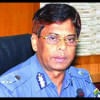
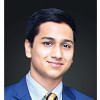
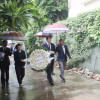
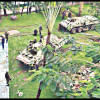


Comments